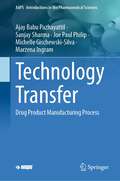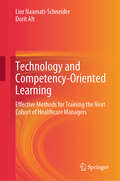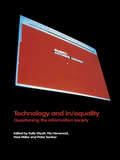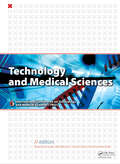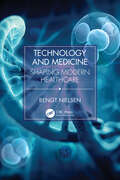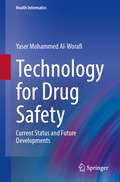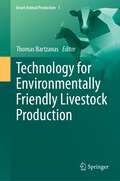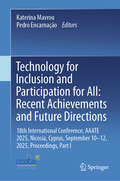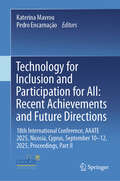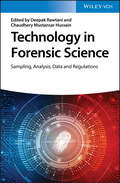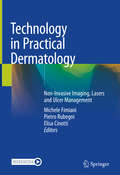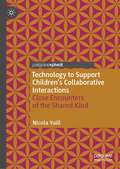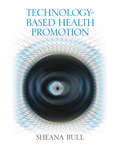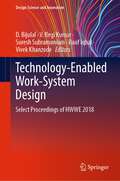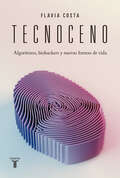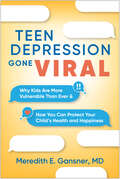- Table View
- List View
Technology Transfer: Drug Product Manufacturing Process (AAPS Introductions in the Pharmaceutical Sciences #10)
by Sanjay Sharma Ajay Babu Pazhayattil Marzena Ingram Joe Paul Philip Michelle Gischewski-SilvaCurrently, there are no textbooks on drug product manufacturing technology transfer that incorporate the latest regulatory expectations. Recent guidance from regulatory bodies such as the US FDA, EMEA, WHO, and PIC/S has adopted the ICH Lifecycle approach harmonizing concepts across regulatory guidance. This allows organizations to align their technology transfer activities for all regulated markets. However, there is a need for consensus and direction in approaching technology transfer, particularly in understanding how to manage the scale-up effects to ensure regulatory compliance.This textbook offers technology transfer solutions and guidance to the pharmaceutical industry. The chapters provide a systematic understanding of applying the technology transfer concepts in pharmaceutical manufacturing, promoting standardization within the industry. Since Stage 1b is not specified in detail within the regulations, pharmaceutical organizations are left to determine the requirements of the stage. The need to justify the methodologies and utilization of sound science makes it more demanding. The textbook’s authors provide innovative solutions for technology transfer challenges, making it a comprehensive reference document. The approaches can be applied to both small-molecule and large-molecule drug product manufacturing segments, addressing the unmet needs of the industry.
Technology and Adolescent Mental Health
by Megan A. Moreno Ana RadovicThis comprehensive book provides a framework for healthcare providers working with the dual challenges and opportunities presented by the intersection of mental health and technology. Technology and Adolescent Mental Health provides recent, evidence-based approaches that are applicable to clinical practice and adolescent care, with each chapter including a patient case illustrating key components of the chapter contents. Early chapters address the epidemiology of mental health, while the second section of the book deals with how both offline and online worlds affect mental health, presenting both positive and negative outcomes, and focusing on special populations of at-risk adolescents. The third section of the book focuses on technology uses for observation, diagnosis or screening for mental health conditions. The final section highlights promising future approaches to technology, and tools for improving intervention and treatment for mental health concerns and illnesses. This book will be a key resource for pediatricians, family physicians, internal medicine providers, adolescent medicine and psychiatry specialists, psychologists, social workers, as well as any other healthcare providers working with adolescents and mental health care.
Technology and Competency-Oriented Learning: Effective Methods for Training the Next Cohort of Healthcare Managers
by Dorit Alt Lior Naamati-SchneiderThis book provides insights into the development of competency-based learning approaches and specific instructional activities designed to enhance healthcare management students’ twenty-first-century skills (21CS). These skills encompass three core domains: cognitive, intra-personal, and inter-personal. The book explores how these skills can be advanced within the intricate dynamics of healthcare systems at macro, meso, and micro levels, emphasizing the imperative need for healthcare professionals to adapt to rapid technological and global changes. Structured into twelve chapters, the book begins with an overview of the complex healthcare environment, highlighting transformative changes and challenges. It then delves into the core theme of competency-based learning, showcasing a shift from traditional teaching methods to constructivist approaches that enhance real-world skills through interactive methods. This approach is crucial for fostering the necessary skills in healthcare managers and other healthcare professionals, which are increasingly vital in today's digital and dynamic medical landscape. The book serves as an extensive resource and guide for healthcare students, faculty, researchers, curriculum designers, policymakers, and current and future healthcare leaders. It offers practical methodologies, innovative teaching methods, and insightful case studies, making it a valuable reference for healthcare and pedagogical research.
Technology and Global Public Health
by Padmini Murthy Amy AnsehlThis book explores the pivotal role played by technology over the past decade in advancing global public health and health care. At present, the global community faces unprecedented healthcare challenges fueled by an aging population, rising rates of chronic disease, and persistent health disparities. New technologies and advancements have the potential to extend the reach of health professionals while improving quality and efficiency of service delivery and reducing costs within the public and the private health systems. The chapters highlight the barriers faced by the global healthcare workforce in using technology to promote health and human rights of communities:Role of Digital Health, mHealth, and Low-Cost Technologies in Advancing Universal Health Coverage in Emerging EconomiesTelehealth and Homecare AgenciesTechnology and the Practice of Health Education in Conflict ZonesThe Worldwide Digital Divide and Access to Healthcare TechnologyTechnology for Creating Better Professional Teams to Strengthen Healthcare SystemsGlobal Public Health Disaster Management and TechnologyAs a resource on the evolution of technology as a valuable and integral component in the promotion and practice of public health and health care, with a focus on SDG 3 targets, Technology and Global Public Health should engage students, instructors, practitioners, and other professionals interested in public health, universal health care, health technology, digital health, and health equity.Dr. Murthy has been a respected leader and mentor on scientific health-related matters within the UN system for many years. Her book develops a theoretical system connecting concepts that have coined global public health with the rapid development of technology, all with the focus to achieve Sustainable Development Goal number three, within the time frame set by World Leaders. - Henry L. Mac-Donald, Former Permanent Representative of Suriname to the United Nations
Technology and In/equality: Questioning the Information Society
by Sally Wyatt Nod Miller Flis Henwood Peter SenkerTechnology and In/equality explores the diverse implications of the new information and communication technologies through case studies of their applications in three main areas - media, education and training, and work. Questions of access to and control over crucial resources such as information, knowledge, skills and income ae addressed drawing upon insights from science and technology studies, innovation theory, sociology and cultural studies. All of the chapters question the meanings of the terms 'technology' and 'inequality' and of the widespread association of technology with progress. Written with a non-specialist readership in mind, all complex theories and key concepts are carefully explained making the book easily accessible and relevant to a wide range of courses.
Technology and Medical Sciences
by João Manuel R.S. Tavares R.M. Natal JorgeThe use of more robust, affordable, and efficient techniques and technologies in the application of medicine is presently a subject of huge interest and demand. Technology and Medical Sciences solidifies knowledge in the fields of technology and medical sciences and to define their key stakeholders. The book is designed for academics in engineering, mathematics, medicine, biomechanics, computation sciences, hardware development and manufacturing, electronics and instrumentation, and materials science.
Technology and Medicine: Shaping Modern Healthcare
by Bengt NielsenTaking a holistic approach, this book describes the developments in medicine and medical technology from ancient times to modern days. It is an exciting journey where readers will learn about the many great inventions by people that did not take the knowledge of their times as a fact. They challenged mysticism, beliefs, the religion, and the Church. They were true scientists long before we knew how to define what a scientist is. This book is, in a way, connecting the dots between the past and the future within healthcare. Features * Provides details on further developments that gave new and exceptional information for diagnostic or therapeutic purposes Gives the reader a new perspective and a common thread of life on medicine and MedTech as well as an improved understanding of how far we have come and how much there still is to work on before we fully understand the human body and its functionality Discusses and gives insight into ongoing research projects that could become clinically available in the future
Technology for Drug Safety: Current Status and Future Developments (Health Informatics)
by Yaser Mohammed Al-WorafiThis book presents information about the use of technology to support the prevention and management of drug safety issues: pharmacovigilance (PV), medication errors, drug-related problems (DRPs), counterfeit medicines and other drug safety issues. Adapting new technologies/information technologies, mobile technologies and social media has contributed effectively to safety practices for medications, with this book providing comprehensive information as a guide to its challenges and potential. Technology for Drug Safety provides practicing and trainee pharmacists, pharmacy technicians, pharmacy educators, researchers, public health policy makers, healthcare professionals and medical educators with vital information about the impact of technology on drug safety-related issues. It describes the current status of the practice, the challenges in the field and recommendations for the effective use of technology in drug safety practice including clinical trials and drug development, PV, detection of adverse drug reactions, reporting and management, medication errors detection, reporting and management, DRPs, counterfeit and substandard medications, and other safety issues.
Technology for Environmentally Friendly Livestock Production (Smart Animal Production)
by Thomas BartzanasThis volume compiles state-of-the-art scientific knowledge on the technologies that are used to quantify and reduce the environmental impact of livestock production in the cattle, pig and poultry industries. It makes a serious statement about how such technology can contribute to the sustainability of the livestock industry in the future.As the global livestock sector is growing, modern farm animal production is increasingly regarded as a source of solid, liquid, gaseous and dust emissions, which can be both nuisance and environmentally harmful. In light of hardening regulations and social pressure, there is increasing interest in scientific research on air pollution and emissions from livestock operations.The present chapters focus on methodology improvement, harmonization of measurements, and modeling aspects. Key aspects, such as renewable energy sources, nutritional approaches to reduce enteric methane emissions, technical options for manure management, and the use of sensors, are covered. By sharing good practices, this book is a valuable reference for a diverse readership. Experts across the veterinary and animal sciences, agricultural engineering, the food industry and sustainability research will benefit from the findings.
Technology for Inclusion and Participation for All: 18th International Conference, AAATE 2025, Nicosia, Cyprus, September 10-12, 2025, Proceedings, Part I
by Pedro Encarnação Katerina MavrouThis two-volume set constitutes the proceedings of the 18th biennial AAATE Conference on Technology for Inclusion and Participation for All: Recent Achievements and Future Directions, AAATE 2025, which took place in Nicosia, Cyprus, during September 10-12, 2025. The 107 full papers included in the proceedings were carefully reviewed and selected from a total of 224 submissions. This collection of papers explores the intersection of advanced technologies, accessibility, and inclusion across education, healthcare, and the workplace. It emphasizes the development and implementation of assistive technologies to support individuals with diverse needs, particularly those with cognitive, sensory, and mobility impairments, and older adults. The key topics explored are as follows: · Inclusive education and workplace participation: How to exploit digital tools, Universal Design for Learning, and AI to foster inclusive learning environments and equitable access to employment. · Digital accessibility: How to plan and design accessible digital spaces to enhance digital inclusion. · Assistive technology for mobility and navigation: Exploring advances in wheelchairs technologies, mobility and indoor navigation systems to enhance autonomy and participation for all users. · Assistive technology in healthcare and rehabilitation: Understanding how to integrate interactive technologies such as virtual reality, eye-tracking, and serious games for diagnosing and rehabilitation of neurodevelopmental disorders, and integrating assistive technologies in healthcare settings. · Artificial Intelligence and robotics: Exploring AI's role in care ecosystems, higher education,
Technology for Inclusion and Participation for All: 18th International Conference, AAATE 2025, Nicosia, Cyprus, September 10-12, 2025, Proceedings, Part II
by Pedro Encarnação Katerina MavrouThis two-volume set constitutes the proceedings of the 18th biennial AAATE Conference on Technology for Inclusion and Participation for All: Recent Achievements and Future Directions, AAATE 2025, which took place in Nicosia, Cyprus, during September 10-12, 2025. The 107 full papers included in the proceedings were carefully reviewed and selected from a total of 224 submissions.This collection of papers explores the intersection of advanced technologies, accessibility, and inclusion across education, healthcare, and the workplace. It emphasizes the development and implementation of assistive technologies to support individuals with diverse needs, particularly those with cognitive, sensory, and mobility impairments, and older adults.The key topics explored are as follows:· Inclusive education and workplace participation: How to exploit digital tools, Universal Design for Learning, and AI to foster inclusive learning environments and equitable access to employment.· Digital accessibility: How to plan and design accessible digital spaces to enhance digital inclusion.· Assistive technology for mobility and navigation: Exploring advances in wheelchairs technologies, mobility and indoor navigation systems to enhance autonomy and participation for all users.· Assistive technology in healthcare and rehabilitation: Understanding how to integrate interactive technologies such as virtual reality, eye-tracking, and serious games for diagnosing and rehabilitation of neurodevelopmental disorders, and integrating assistive technologies in healthcare settings.· Artificial Intelligence and robotics: Exploring AI's role in care ecosystems, higher education, and robotic assistance, especially for children and aging populations.· Assistive Technology design and impact: Focusing on user-centered co-design, outcome measurement, and training to ensure effective and sustainable assistive technology solutions.· Communication and cognitive support: Advancing augmentative and alternative communication (AAC) tools and technologies tailored for cognitive disabilities.· Cultural and social inclusion: Promoting inclusive experiences in public spaces like museums through co-design and emerging technologies.
Technology in Forensic Science: Sampling, Analysis, Data and Regulations
by Deepak RawtaniThe book "Technology in Forensic Science" provides an integrated approach by reviewing the usage of modern forensic tools as well as the methods for interpretation of the results. Starting with best practices on sample taking, the book then reviews analytical methods such as high-resolution microscopy and chromatography, biometric approaches, and advanced sensor technology as well as emerging technologies such as nanotechnology and taggant technology. It concludes with an outlook to emerging methods such as AI-based approaches to forensic investigations.
Technology in Practical Dermatology: Non-Invasive Imaging, Lasers and Ulcer Management
by Elisa Cinotti Michele Fimiani Pietro RubegniThis book provides a complete overview on the latest available technologies in dermatology, while discussing future trends of this ever-growing field. This handy guide provides clinicians and researchers with a clear understanding of the advantages and challenges of laser and imaging technologies in skin medicine today. It also includes a section on imaging techniques for the evaluation of skin tumors, with chapters devoted to dermoscopy, in vivo and ex vivo reflectance confocal microscopy, high frequency ultrasound, optical coherence tomography, and a closing part on latest approaches to wound management.Completed by over 200 clinical images, Current Technology in Practical Dermatology: Non-Invasive Imaging, Lasers and Ulcer Management is both a valuable tool for the inpatient dermatologist and for physicians, residents, and medical students in the field.
Technology in Social Work Education and Curriculum: The High Tech, High Touch Social Work Educator
by Florence W Vigilante Richard L Beaulaurier Martha F HaffeySave time and trouble as you incorporate technology into your social work curriculumThe dramatic increase in the use of computers and other forms of technology in social work education and practice has educators, trainers, and administrators investing valuable time, money, and effort into trying to make the transition from traditional teaching to a Web-assisted learning environment. Technology in Social Work Education and Curriculum takes the mystery out of the online experience with practical information on using technology to enhance and enrich learning-but not at the expense of the "human" approach to social work. This unique book presents a variety of creative and interesting methods for incorporating technology that&’s affordable and user-friendly, and for developing online skills that won&’t become obsolete as computer hardware and software evolves.Technology in Social Work Education and Curriculum transforms technology into an everyday resource for agency field instructors, human service educators, trainers, and social work administrators. The book addresses concerns that educators with limited technical skills may have in using technology to teach cultural competency, group work, research, direct practice, social policy and advocacy, and field practicum, presenting hands-on approaches that are innovative but accessible. And by focusing on approaches rather than simply reviewing available hardware and software, the book provides you with background knowledge that makes it easier for you to successfully incorporate online learning into the classroom. Technology in Social Work Education and Curriculum examines using instructional technology to emotionally engage students in the learning process using digital video and qualitative data analysis software to teach group practice the role technology plays in advocacy distance-education technologies in policy education incorporating Web-assisted learning into a traditional classroom setting the advantages of distance education over more conventional approaches a model for planning the use and integration of computer technology in schools of social work how the behaviors of computer consultants can affect the students who seek their help using innovation diffusion theory in technology planning and much more!Social workers have traditionally embraced the latest technologies and scientific developments since the earliest days of the profession. Technology in Social Work Education and Curriculum helps continue that tradition, offering invaluable guidance to educators and administrators, no matter how experienced-or inexperienced-they are in dealing with communications technologies.
Technology in the Hospital: Transforming Patient Care in the Early Twentieth Century
by Joel HowellPhysicians, Patients, and Medical Technology, Science, Scientific Systems, and Surgery, The Changing meaning of Urinalysis, Clinical use of the X-Ray Machine, The X-Ray Image, Blood and Blood Counts, Blood and Diseases, Machines and Medicine.
Technology to Support Children's Collaborative Interactions: Close Encounters of the Shared Kind
by Nicola YuillThis book explores how technology can foster interaction between children and their peers, teachers and other adults. It presents the Co-EnACT framework to explain how technology can support children to collaborate, so helping them to learn and engage enjoyably with the world, in both work and play. The focus is on children, rather than young people, but the principles of supporting interaction apply throughout all life stages. Chapters on classrooms and on autism explain principles behind using technology in ways that support, rather than obstruct, social interaction in diverse populations. Collaborative interaction involves both verbal and non-verbal behaviour and this book presents evidence from closely analysing children’s behaviour in natural settings. Examples from cutting-edge technology illustrate principles applicable to more widely-available technology. The book will be of interest to psychologists, educators, researchers in Human–Computer Interaction (HCI), particularly those designing with children in mind, and practitioners working with children who want to deepen their understanding of using technology for collaboration.
Technology-Assisted Interventions for Substance Use Disorders
by Jonathan Avery Mashal KhanThis book examines the role of technology-assisted interventions for substance use disorders (SUD). It considers this topic alongside the dramatic increase in SUDs and associated harm in the United States’ past decade.Chapters relay the impact and effectiveness of technology-assisted interventions, which include telemedicine, assisted therapies, and support. These treatments not only offer practical care but also address the issue of access to care, particularly in the wake of the global pandemic (COVID-19). Organized into three sections, section one covers the use of telemedicine and technology-assisted therapies as it relates to the treatment of various SUDs, achieving recovery and maintenance. Each chapter will expand on a specific aspect of technology-assisted intervention. Following this, section two explores the differences in technology-assisted interventions and approaches while taking into account age, gender, sexuality, identity, and psychosocial factors. This section will be divided into chapters on children and adolescents, women and pregnancy, older adults, LGBTQIA+, and professionals. To close the book, section three discusses the media impact on SUDs and the legal technology adopted by drug courts.Unique and timely, Technology-Assisted Interventions for Substance Use Disorders is an invaluable resource to learners and practitioners in the field. It provides a concise yet comprehensive summary of the current status of the field that will help guide the implementation of technology-assisted interventions for all SUDs into practice and stimulate investigative efforts.
Technology-Based Health Promotion
by Dr Sheana BullThis is the first textbook of its kind to offer students an introduction to best practices for using technology in health promotion programs. Integrating detailed case studies and interactive skill-building exercises throughout, this succinct and practical text teaches students to identify the most appropriate technology to meet their goals.
Technology-Enabled Work-System Design: Select Proceedings of HWWE 2018 (Design Science and Innovation)
by Rauf Iqbal Vivek Khanzode Bijulal D. Regi Kumar V Suresh SubramoniamThis volume presents selected papers presented during the 16th International Conference on Humanizing Work and Work Environment (HWWE 2018). The book presents a confluence of ideas on ergonomics and technology implementation to improve workplace environments and work systems to maximize effectiveness and performance. The volume is thematically arranged, with papers covering different aspects of ergonomics and design. The volume will be of use to researchers, practitioners and students working in different fields of ergonomics.
Technosleep: Frontiers, Fictions, Futures
by Simon J. Williams Robert Meadows Michael Greaney Eric L. Hsu Catherine CoveneyThis book draws on a variety of substantive examples from science, technology, medicine, literature, and popular culture to highlight how a new technoscientifically mediated and modified phase and form of technosleep is now in the making – in the global north at least; and to discuss the consequences for our relationships to sleep, the values we accord sleep and the very nature and normativities of sleep itself.The authors discuss how technosleep, at its simplest denotes the ‘coming together’ or ‘entanglements’ of sleep and technology and sensitizes us to various shifts in sleep–technology relations through culture, time and place. In doing so, it pays close attention to the salience and significance of these trends and transformations to date in everyday/night life, their implications for sleep inequalities and the related issues of sleep and social justice they suggest.
Tecklin's Pediatric Physical Therapy
by Elena McKeough Spearing Eric S. Pelletier Mark DrnachTrusted for decades by Physical Therapy students as well as experienced therapists who want to improve their knowledge, Tecklin’s Pediatric Physical Therapy provides a comprehensive and logical overview of some of the most common pediatric physical therapy diagnoses. This straightforward approach presents basic medical information regarding common clinical diagnostic categories followed by coverage of physical therapy examination, intervention and special considerations within each diagnostic group. Content in this 6th Edition has been thoroughly updated and reorganized to help prepare students for today’s clinical challenges, accompanied by case studies and interactive features that reinforce understanding and instill the clinical decision-making skills essential to successful practice.
Tecnoceno: Algoritmos, biohackers y nuevas formas de vida
by Flavia CostaDescripción de esta era en la que, mediante la puesta en marcha de tecnologías de alta complejidad y altísimo riesgo, dejamos huellas en el mundo que exponen no solo a las poblaciones de hoy, sino a las generaciones futuras, de nuestra especie y de otras especies, en los próximos milenios. Chernóbil, la crisis financiera de 2008, los incendios en el Amazonas o la pandemia de coronavirus no son eventos aislados. Son "accidentes normales", síntomas del crecimiento y la destrucción acelerados, que, en menos de setenta años, transformaron nuestra vida y la del planeta para siempre. En Tecnoceno Flavia Costa delinea con sutileza la trama cultural y política de este mundoambiente alucinatorio cuya virtualidad se sostiene en una red material hecha de cables, satélites y edificios, por donde desfilan bioartistas, ciencia forense, organizaciones de derechos humanos, sistemas de vigilancia y empresarios transhumanistas. Y advierte sobre el papel clave que cumplen hoy las huellas: las biométricas, las comportamentales y las que dejamos en el suelo, la atmósfera y los océanos. Unas porque su capitalización ha desatado una feroz batalla geopolítica. Otras porque de ellas depende el futuro de la Tierra. «Los "accidentes normales" no son producto de una guerra, una negligencia o un sabotaje, sino que son inseparables de la productividad del sistema, de su desarrollo, de su incremento y de las contingencias que siempre se abren cuando se dispara una acción tecnológica hipercompleja hacia el futuro.» «Estamos ante una nueva cultura del yo que se exhibe ante los demás; un sujeto que, así como asume la individualidad somática, se reconoce también como emisor continuo de señales, como obra viviente, que se experimenta, se expresa, se juzga y actúa sobre sí, en parte, en el lenguaje del espectáculo. Y que se entrena como creador de su propia audiencia.»
Tecnologías que enferman: Efectos nocivos de la contaminación electromagnética y cómo protegerse
by Juan Adrián Karca Rafael Hernandez MoscosoAprenda a cómo protegerse de la contaminación electromagnética. Los aparatos electrónicos se están tomando nuestra vida: vivimos conectados a un celular, un computador, un televisor, una tableta. Hay muchas ventajas del desarrollo pero también hay un lado más sombrío del que pocos hablan: la tecnología moderna tiene efectos negativos en nuestra salud debido a la contaminación eléctrica y magnética que produce. Cada vez la evidencia es más contundente sobre los impactos que tiene en el sistema inmune, el sistema neurológico y la salud mental, entre otros. El propósito de este libro es que cualquiera que lo lea pueda conocer y tomar conciencia de la contaminación invisible proveniente dela tecnología que lo rodea. Este libro revela los avances científicos que se han hecho para determinar los efectos nocivos de estas radiaciones, muestra formas prácticas para protegerse de la contaminación electromagnética y contiene una guía para que el lector determine si es una posible víctima de estas energías.
Teen Depression Gone Viral: Why Kids Are More Vulnerable Than Ever and How You Can Protect Your Child's Health and Happiness
by Meredith E. GansnerWhat are the warning signs of depression in teens? When do social media and gaming habits cross the line into putting kids at risk? How can parents keep teens healthy and safe--without sledgehammering all their devices? This realistic, nonjudgmental guide from adolescent psychiatrist and parent Meredith E. Gansner provides the latest information about depression in teens, with a special focus on digital media use. Filled with vivid stories, the book helps you understand teen mental health problems and self-harm; find an accurate diagnosis; work with your child to develop healthier habits, aided by downloadable practical tools; and make informed treatment decisions. Dr. Gansner explores myths and facts about internet addiction, dangerous viral trends, and cyberbullying, and describes actionable steps for curbing them. Every chapter also identifies positive technology resources for both kids and parents, from supportive online communities to health-promoting sites and apps.
Teen Suicide Risk
by Cynthia Ewell Foster Kelly M. Rogalski Cheryl A. KingMeeting a vital need, this book helps clinicians rapidly identify risks for suicidal behavior and manage an at-risk teen's ongoing care. It provides clear guidelines for conducting suicide risk screenings and comprehensive risk assessments and implementing immediate safety-focused interventions, as well as longer-term treatment plans. Designed for day-to-day use in private practice, schools, or other settings, the volume is grounded in a strong evidence base. It features quick-reference clinical pointers, sample dialogues with teens and parents, and reproducible assessment and documentation tools. Purchasers get access to a Web page featuring most of the reproducible materials, ready to download and print in a convenient 8 1/2" x 11" size.
